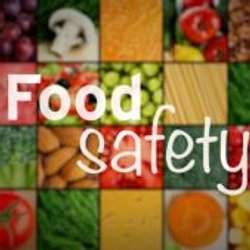The Ultimate Guide to Food Safety Certification: Ensuring Safe and Quality Food Practices

Introduction:
Food safety certification plays a crucial role in the food industry, ensuring that food products are safe for consumption and meet the highest standards of quality. With the ever-increasing complexity of the global food supply chain and the potential risks associated with foodborne illnesses, food safety certification has become a fundamental requirement for food businesses worldwide. It provides a framework and set of guidelines to mitigate risks, prevent contamination, and maintain the integrity of food products from farm to fork.
The primary purpose of food safety certification is to protect public health by establishing a systematic approach to managing food safety hazards. Certification programs are designed to verify that food businesses have implemented effective control measures and are in compliance with applicable regulations and industry standards. By obtaining food safety certification, businesses demonstrate their commitment to providing safe and quality food products to consumers.
Food safety certification serves several key objectives. Firstly, it helps to prevent foodborne illnesses by ensuring that food businesses adhere to rigorous hygiene practices and control measures throughout the production, processing, and distribution processes. Certification programs typically require businesses to implement robust food safety management systems, such as Hazard Analysis and Critical Control Points (HACCP) or the ISO 22000 standard, to identify and control potential hazards.
Secondly, food safety certification enhances consumer confidence in the safety and quality of food products. With increasing awareness and concerns about foodborne diseases, consumers are more inclined to choose products from certified sources. Food businesses that obtain certification can use it as a powerful marketing tool, demonstrating their commitment to food safety and distinguishing themselves from competitors.
Thirdly, food safety certification helps businesses meet regulatory requirements and stay in compliance with local, national, and international food safety standards. Regulatory agencies often reference certification programs as benchmarks for evaluating food safety practices. By obtaining certification, food businesses demonstrate their adherence to these standards, which can streamline regulatory processes and reduce the risk of non-compliance.
In conclusion, food safety certification is vital for the food industry to ensure public health, maintain consumer trust, and meet regulatory requirements. It provides a systematic approach to managing food safety hazards and demonstrates a commitment to delivering safe and quality food products. Throughout this guide, we will delve into the intricacies of food safety certification, exploring the certification process, benefits, challenges, and best practices for successful implementation and maintenance. By understanding and embracing food safety certification, businesses can establish themselves as leaders in the industry and contribute to a safer and more sustainable food supply chain.
Section 1: Understanding Food Safety Certification
1.1 What is Food Safety Certification?
Food safety certification refers to the process of verifying and validating that food businesses have implemented and maintained effective food safety management systems and practices. It involves independent assessment by accredited certification bodies to ensure compliance with established food safety standards. Food safety certification provides assurance to consumers, regulators, and other stakeholders that the certified food products meet the highest standards of safety and quality.
There are several internationally recognized food safety standards that serve as the basis for certification. These standards outline the requirements and criteria that food businesses must meet to achieve certification. Some of the prominent food safety standards include:
- Hazard Analysis and Critical Control Points (HACCP): HACCP is a systematic approach to identifying, evaluating, and controlling food safety hazards. It is a preventive system that focuses on critical control points throughout the food production process.
- International Organization for Standardization (ISO) 22000: ISO 22000 is a global standard for food safety management systems. It incorporates the principles of HACCP and provides a comprehensive framework for managing food safety risks.
- Safe Quality Food (SQF): SQF is a certification program that focuses on food safety and quality management. It sets rigorous standards for food production, storage, and distribution.
- British Retail Consortium (BRC) Global Standard for Food Safety: The BRC standard is widely recognized and used by retailers and manufacturers globally. It covers food safety, quality, and operational criteria.
- Global Food Safety Initiative (GFSI) Recognized Schemes: GFSI is an international collaboration between food safety experts from the retail, manufacturing, and food service industries. GFSI benchmarks various food safety standards, ensuring their equivalency and credibility.
Certification bodies are responsible for conducting audits and assessments to determine if a food business meets the requirements of the chosen food safety standard. These bodies are accredited by recognized accreditation bodies, which verify their competence and impartiality. Accreditation adds credibility and ensures that the certification process is conducted consistently and objectively.
In summary, food safety certification is the process of verifying that food businesses meet established food safety standards. It provides confidence to consumers, regulators, and stakeholders that the certified products are safe and of high quality. By adhering to recognized food safety standards and working with accredited certification bodies, food businesses can demonstrate their commitment to food safety and gain a competitive edge in the marketplace.
1.2 Benefits of Food Safety Certification
Obtaining food safety certification offers numerous benefits for food businesses across the entire supply chain. Here are some key advantages of achieving food safety certification:
- Consumer Trust: Food safety certification instills confidence in consumers that the certified products meet stringent safety and quality standards. It demonstrates a commitment to protecting consumer health and well-being, leading to increased trust and loyalty. Consumers are more likely to choose certified products over non-certified ones.
- Regulatory Compliance: Food safety certification helps businesses meet regulatory requirements and demonstrate compliance with food safety regulations. Certification provides evidence of adherence to best practices, ensuring that the food business meets legal obligations and avoids penalties or legal issues.
- Improved Food Safety Practices: The certification process involves a thorough evaluation of a food business’s food safety management systems, including processes, procedures, and documentation. This assessment highlights areas for improvement and encourages businesses to implement robust food safety practices. It leads to enhanced control over hazards, reduction in foodborne illnesses, and improved overall food safety performance.
- Market Access and Competitiveness: Food safety certification is often a prerequisite for accessing certain markets, especially for export-oriented businesses. Many retailers, distributors, and buyers require suppliers to hold food safety certification to ensure consistent quality and safety of the products. Certification enhances a business’s marketability and competitiveness, opening doors to new business opportunities and partnerships.
- Continuous Improvement: Food safety certification promotes a culture of continuous improvement within the organization. It requires regular internal audits, reviews, and corrective actions, driving ongoing refinement of food safety practices. Continuous improvement ensures that the business stays updated with the latest industry trends, technological advancements, and regulatory changes, leading to enhanced efficiency and effectiveness.
- Supplier Relationships: Food safety certification enhances relationships with suppliers and other stakeholders in the supply chain. Certification demonstrates a commitment to quality and safety, reassuring suppliers of the business’s capability to handle their products safely. It fosters trust and collaboration, leading to stronger partnerships and supply chain resilience.
- Brand Reputation and Differentiation: Food safety certification helps build a strong brand reputation as a responsible and trustworthy food business. Certified businesses can leverage their certification to differentiate themselves from competitors, attract new customers, and retain existing ones. Certification signals a commitment to quality, safety, and customer satisfaction, enhancing the overall brand image.
In conclusion, food safety certification offers significant advantages for food businesses. It builds consumer trust, ensures regulatory compliance, improves food safety practices, expands market access, promotes continuous improvement, strengthens supplier relationships, and enhances brand reputation. By obtaining food safety certification, businesses demonstrate their commitment to producing safe and high-quality food, giving them a competitive edge in the marketplace.
1.3 Regulatory Framework for Food Safety Certification
Food safety certification is governed by a comprehensive regulatory framework at both the international and national levels. These regulations aim to ensure that food businesses meet the required safety standards and comply with legal obligations. Let’s explore the key aspects of the regulatory framework for food safety certification.
International Regulations:
- Several international organizations play a vital role in setting food safety standards and guidelines. The most prominent among them are:
- Codex Alimentarius Commission: Codex develops international food standards, guidelines, and codes of practice to protect consumer health and ensure fair practices in the food trade. Their standards cover a wide range of topics, including food hygiene, labeling, and contaminants.
- International Organization for Standardization (ISO): ISO has developed various food safety management system standards, including ISO 22000:2018, which provides a framework for developing and implementing a food safety management system.
- World Health Organization (WHO): WHO provides technical guidance and recommendations on food safety, including the control of foodborne diseases and the promotion of good hygiene practices.
National Regulations:
Each country has its own regulatory framework for food safety, which may include:
- Food Safety Laws and Regulations: Countries enact specific laws and regulations that outline the requirements for food safety, including the need for certification. These regulations often cover areas such as hygiene practices, labeling, traceability, and control of hazards.
- Food Safety Authorities: National food safety authorities are responsible for implementing and enforcing food safety regulations. They may conduct inspections, audits, and certifications or designate authorized bodies to carry out these activities.
- Certification Bodies: Accredited certification bodies, authorized by national food safety authorities, are responsible for assessing and certifying food businesses against recognized food safety standards. These bodies ensure that the certification process is conducted impartially and in accordance with established procedures.
Legal Obligations and Compliance Standards:
Food businesses are legally obligated to comply with the relevant food safety regulations in their jurisdiction. Compliance includes:
- Implementation of Food Safety Management Systems: Food businesses are required to establish and maintain effective food safety management systems based on recognized standards. This includes documenting procedures, conducting hazard analyses, implementing control measures, and monitoring and verifying the effectiveness of these measures.
- Hygiene Practices: Food businesses must adhere to good hygiene practices throughout their operations, including proper handling, storage, preparation, and transportation of food.
- Traceability and Recall Procedures: Food businesses must have systems in place to track and trace their products, enabling them to initiate timely recalls if necessary.
- Documentation and Record-Keeping: Accurate documentation and record-keeping are essential to demonstrate compliance with food safety regulations. This includes maintaining records of processes, procedures, training, inspections, and audits.
Failure to comply with food safety regulations can result in penalties, recalls, loss of consumer trust, and potential legal consequences.
In conclusion, food safety certification operates within a regulatory framework that encompasses international standards and guidelines as well as national laws and regulations. These regulations establish legal obligations for food businesses to ensure the safety and quality of their products. Compliance with these standards is crucial for maintaining public health and consumer confidence in the food industry. By understanding and adhering to the regulatory requirements, food businesses can meet their legal obligations and contribute to a safer and more secure food supply chain.
Section 2: Food Safety Management Systems
2.1 Introduction to Food Safety Management Systems
Food Safety Management Systems (FSMS) play a critical role in ensuring the safety and quality of food products. These systems provide a framework for identifying and controlling food safety hazards throughout the food supply chain. Two widely recognized and implemented food safety management systems are Hazard Analysis and Critical Control Points (HACCP) and ISO 22000. Let’s explore these systems in detail:
- Hazard Analysis and Critical Control Points (HACCP): HACCP is a systematic approach to food safety management that focuses on identifying and controlling potential hazards at specific points in the food production process. The key principles of HACCP include:
- Hazard Analysis: This involves identifying and assessing biological, chemical, and physical hazards that may be present in food.
- Critical Control Points (CCPs): CCPs are specific points in the production process where control measures can be applied to prevent, eliminate, or reduce hazards to an acceptable level.
- Critical Limits: These are the maximum or minimum values at which control measures must be maintained to prevent or eliminate hazards.
- Monitoring: Regular monitoring and verification activities are conducted to ensure that CCPs are under control and hazards are effectively managed.
- Corrective Actions: Procedures are established to address deviations from critical limits, ensuring that appropriate corrective actions are taken to maintain food safety.
HACCP is widely recognized and mandated by regulatory authorities in many countries. It provides a systematic approach to identify and control hazards, ensuring the safety of food products.
- ISO 22000: ISO 22000 is an international standard for food safety management systems. It provides a comprehensive framework for organizations to establish, implement, and maintain an FSMS. The key objectives of ISO 22000 include:
- Hazard Control: ISO 22000 emphasizes the identification and control of hazards throughout the food chain, including biological, chemical, and physical hazards.
- Communication: The standard promotes effective communication within the organization and with external parties involved in the food chain to ensure food safety.
- Management Commitment: ISO 22000 requires top management commitment to establish and maintain an effective FSMS, providing the necessary resources and support.
- Continual Improvement: The standard emphasizes the importance of continual improvement in food safety performance through monitoring, measurement, analysis, and evaluation.
ISO 22000 is designed to be compatible with other management system standards, such as ISO 9001 (Quality Management) and ISO 14001 (Environmental Management). This allows organizations to integrate their food safety management system with other systems, facilitating a holistic approach to overall business management.
Both HACCP and ISO 22000 are widely adopted and recognized food safety management systems. While HACCP is more focused on specific control points and critical limits, ISO 22000 provides a broader framework that encompasses the entire food chain. Organizations can choose the most suitable system based on their specific needs, industry requirements, and regulatory compliance.
By implementing robust food safety management systems like HACCP and ISO 22000, food businesses can effectively identify and control hazards, ensure compliance with food safety regulations, and protect consumer health and confidence. These systems provide a systematic and proactive approach to managing food safety, promoting the production of safe and high-quality food products.
2.2 Implementing Food Safety Management Systems
Implementing a food safety management system within a food business involves a systematic approach to identify and control hazards throughout the production process. Here is a step-by-step guide to implementing food safety management systems:
- Conduct a Hazard Analysis: Start by identifying potential hazards in each stage of the food production process. This includes biological, chemical, and physical hazards that could pose risks to food safety.
- Determine Critical Control Points (CCPs): Once hazards are identified, determine the critical control points in the process where control measures can be applied to prevent, eliminate, or reduce the identified hazards to an acceptable level.
- Establish Critical Limits: Set critical limits for each identified CCP. These are the maximum or minimum values that must be maintained to ensure food safety. Critical limits serve as benchmarks to determine if a process is under control.
- Implement Monitoring Procedures: Develop procedures to monitor the identified CCPs regularly. Monitoring should involve measuring and recording relevant parameters to ensure that critical limits are being met. This can include temperature checks, visual inspections, microbial testing, or other appropriate methods.
- Establish Corrective Actions: Define clear procedures for taking corrective actions when deviations from critical limits occur. This involves identifying the actions needed to bring the process back under control, investigating the root cause of the deviation, and implementing corrective measures to prevent reoccurrence.
- Implement Verification Procedures: Regularly verify the effectiveness of the food safety management system through internal audits, inspections, and reviews. This ensures that the system is operating as intended and that hazards are being adequately controlled.
- Document and Train: Document all procedures, processes, and controls related to the food safety management system. Provide comprehensive training to employees involved in food handling and production, ensuring they understand their roles and responsibilities in maintaining food safety.
- Continual Improvement: Foster a culture of continuous improvement by regularly reviewing the food safety management system, gathering feedback, and implementing necessary changes. Stay updated with the latest regulations and industry best practices to enhance the effectiveness of the system.
By following this step-by-step guide, food businesses can effectively implement food safety management systems, such as HACCP or ISO 22000. These systems provide a structured approach to identifying and controlling hazards, ensuring the production of safe and high-quality food products while meeting regulatory requirements. Regular monitoring, verification, and continuous improvement are essential to maintaining the effectiveness of the system and protecting consumer health.
2.3 Integration of Food Safety Certification and Management Systems
Food safety certification and food safety management systems go hand in hand to ensure the highest standards of food safety within a food business. While food safety management systems provide a structured approach to identifying and controlling hazards, food safety certification validates the effectiveness of these systems through a third-party audit process. Integrating food safety certification requirements into existing management systems brings several benefits:
- Comprehensive Approach: Integration allows for a comprehensive approach to food safety. By incorporating certification requirements into existing management systems, businesses can address both regulatory compliance and industry best practices in a unified manner. This helps ensure that all aspects of food safety are adequately covered.
- Streamlined Processes: Integration eliminates duplication and streamlines processes. Instead of managing separate systems for food safety management and certification, businesses can consolidate their efforts and resources by integrating the certification requirements into their existing management systems. This reduces administrative burden and enhances efficiency.
- Enhanced Credibility: Integration enhances the credibility of the food safety management system. Food safety certifications, such as those based on recognized standards like HACCP or ISO 22000, provide external validation of a business’s commitment to food safety. Integration demonstrates a proactive approach to ensuring food safety and increases stakeholder confidence in the organization’s ability to meet food safety requirements.
- Cost and Time Savings: Integrating certification requirements into existing management systems can result in cost and time savings. By utilizing existing processes and documentation, businesses can avoid duplicative efforts and reduce the resources required for maintaining separate systems. Additionally, the integration streamlines audit processes, leading to more efficient and cost-effective certification audits.
- Continuous Improvement: Integration supports a culture of continuous improvement. When certification requirements are integrated into the existing management systems, businesses are prompted to regularly review and improve their food safety practices. This ensures that the organization stays proactive in identifying and addressing potential risks and continuously enhances its food safety performance.
Overall, integrating food safety certification requirements into existing management systems offers numerous benefits. It provides a unified approach to food safety, streamlines processes, enhances credibility, saves costs and time, and promotes continuous improvement. By aligning certification requirements with established management systems, businesses can achieve robust food safety practices and meet the expectations of consumers, regulators, and other stakeholders.
Section 3: Food Safety Certification Process
3.1 Selecting the Right Certification Body
Selecting the right certification body is a crucial step in the food safety certification process. Here are some guidelines to consider when choosing a reputable and accredited certification body:
- Expertise and Experience: Look for a certification body that has expertise and experience in food safety certification. They should have auditors who are knowledgeable about food safety standards, regulations, and industry-specific requirements. Consider their track record and experience in certifying businesses similar to yours.
- Accreditation: Ensure that the certification body is accredited by a recognized accreditation body. Accreditation provides assurance that the certification body operates according to internationally recognized standards and practices. Accredited certification bodies undergo regular assessments to ensure competence and impartiality in their certification process.
- Industry Recognition: Consider the certification body’s reputation and recognition within the industry. Look for certifications that are widely accepted and respected by customers, regulatory authorities, and industry stakeholders. A certification from a reputable body enhances your credibility and demonstrates your commitment to food safety.
- Audit Process: Evaluate the certification body’s audit process. Understand their approach to conducting audits, including the frequency and duration of audits, and their methods for assessing compliance. A well-structured audit process should include thorough document review, on-site inspections, interviews with staff, and verification of records.
- Cost and Contractual Requirements: Consider the cost of certification and any contractual requirements associated with the certification body. Request quotes from different certification bodies and compare the fees and services provided. Review the contract terms, including the duration of the certification, renewal process, and any additional costs for surveillance audits or changes in scope.
- Customer Support and Communication: Assess the certification body’s customer support and communication practices. Choose a certification body that provides clear and timely communication throughout the certification process. They should be responsive to your inquiries, provide guidance on compliance requirements, and offer support in addressing any non-conformities or improvement opportunities.
- Continuing Relationship: Consider the potential for a long-term relationship with the certification body. As food safety standards and regulations evolve, ongoing support and guidance from the certification body will be valuable. Select a certification body that demonstrates a commitment to assisting your organization in maintaining compliance and continuous improvement.
By carefully considering these factors, you can select a reputable and accredited certification body that aligns with your organization’s needs and goals. Choosing the right certification body ensures a robust and credible food safety certification that will enhance your organization’s reputation, build trust with stakeholders, and demonstrate your commitment to providing safe and high-quality food products.
3.2 Preparing for Food Safety Certification
Preparing for food safety certification is an essential step for food businesses seeking to achieve and maintain compliance with food safety standards. Here are some key preparation steps to consider:
- Conduct a Gap Analysis: Perform a comprehensive gap analysis to identify areas where your current practices may fall short of the requirements of the food safety standard you are seeking certification for. Compare your existing processes, procedures, and documentation against the standard’s requirements to identify gaps and areas for improvement.
- Review and Update Documentation: Review your existing documentation, such as policies, procedures, work instructions, and records, to ensure they align with the requirements of the food safety standard. Update or develop new documentation as necessary to address any gaps identified during the gap analysis. Documentation should clearly define roles and responsibilities, describe processes, and provide evidence of compliance.
- Implement Good Manufacturing Practices (GMPs): Establish and implement Good Manufacturing Practices, which are fundamental requirements for maintaining food safety and hygiene in your facility. GMPs cover areas such as personnel hygiene, facility cleanliness, equipment maintenance, and pest control. Ensure that GMPs are documented, communicated to staff, and consistently followed.
- Conduct Internal Audits: Perform internal audits to assess the effectiveness and compliance of your food safety management system. Internal audits help identify non-conformities, areas for improvement, and opportunities to strengthen your system. Follow a systematic audit process, including planning, conducting audits, documenting findings, and taking corrective actions. Internal audits should be conducted by trained internal auditors or external consultants with expertise in food safety.
- Establish Corrective and Preventive Actions: Develop a process for addressing non-conformities and implementing corrective and preventive actions. When non-conformities are identified, take immediate action to address the root causes and prevent their recurrence. Document these actions and monitor their effectiveness to ensure sustained compliance.
- Employee Training and Awareness: Provide training to employees on food safety principles, practices, and their roles in maintaining food safety. Ensure that employees understand the importance of their contributions to food safety and are aware of the specific requirements outlined in the food safety standard. Regularly communicate and reinforce food safety policies and practices to promote a culture of food safety throughout the organization.
- Mock Audits: Conduct mock audits or pre-assessments to simulate the certification audit process. These practice audits help identify any remaining gaps or weaknesses in your food safety management system before the actual certification audit. Mock audits also provide an opportunity to train and familiarize your team with the audit process and build confidence in their ability to demonstrate compliance.
By following these preparation steps, food businesses can ensure they are well-prepared for the food safety certification process. Thoroughly addressing any gaps, updating documentation, conducting internal audits, and providing training and awareness to employees will help establish a robust food safety management system and increase the likelihood of a successful certification audit.
3.3 Food Safety Certification Audit
The food safety certification audit is a crucial step in the certification process. It involves an assessment of a food business’s compliance with the requirements of the chosen food safety standard. The audit process typically consists of an initial audit followed by regular surveillance audits. Here is an overview of the certification audit process:
- Initial Audit: The initial audit is conducted by an accredited certification body. It is a comprehensive evaluation of the food business’s compliance with the food safety standard. The audit team will review the documentation, procedures, and practices related to food safety management. They may also conduct site inspections to observe operations, equipment, and facilities. The objective is to assess the organization’s level of compliance with the standard’s requirements and identify any non-conformities.
- Audit Criteria: The audit is conducted based on specific criteria, which are the requirements outlined in the chosen food safety standard. The auditors will assess the organization’s processes, procedures, controls, and records against these criteria. The criteria may cover areas such as hazard analysis, control measures, monitoring, verification, corrective actions, and management commitment.
- Site Inspections: During the audit, the auditors will conduct site inspections to observe the food handling practices, cleanliness of facilities, storage conditions, and adherence to good manufacturing practices. They will assess whether the organization has implemented the necessary controls to prevent food safety hazards and ensure compliance with hygiene and sanitation requirements.
- Compliance Assessments: The auditors will evaluate the organization’s compliance with the food safety standard by reviewing documentation, records, and evidence of implementation. They will assess the effectiveness of the food safety management system in identifying, controlling, and preventing food safety hazards. The auditors may conduct interviews with employees to verify their understanding of food safety practices and their roles in maintaining compliance.
- Non-Conformities: If any non-conformities are identified during the audit, they will be documented. Non-conformities represent areas where the organization fails to meet the requirements of the food safety standard. The auditors will classify the non-conformities based on their severity and provide the organization with a corrective action request, outlining the necessary steps to address the non-conformities.
- Surveillance Audits: After achieving initial certification, regular surveillance audits are conducted to ensure ongoing compliance with the food safety standard. These audits are typically conducted annually or as specified by the certification body. Surveillance audits focus on reviewing the organization’s continued adherence to the standard and assessing the effectiveness of the food safety management system.
- Certificate Issuance: If the organization successfully demonstrates compliance with the food safety standard during the initial audit and subsequent surveillance audits, a food safety certification is issued by the certification body. The certificate confirms that the organization meets the requirements of the standard and has implemented an effective food safety management system.
By understanding the certification audit process, food businesses can adequately prepare for the assessments and ensure compliance with food safety standards. It is essential to maintain documentation, conduct regular internal audits, and continually improve the food safety management system to sustain compliance throughout the certification period.
Section 4: Maintaining Food Safety Certification
4.1 Compliance and Continuous Improvement
Maintaining food safety certification requires a strong commitment to ongoing compliance and continuous improvement. Compliance involves adhering to the requirements of the food safety standard and relevant regulatory obligations. Continuous improvement, on the other hand, focuses on enhancing food safety practices beyond the minimum requirements. Here’s an explanation of both aspects:
- Compliance:
Ongoing compliance with food safety standards and regulations is essential to maintain food safety certification. It involves consistently following the documented procedures, controls, and practices outlined in the food safety management system. This includes conducting regular monitoring and verification activities, such as internal audits, to ensure that processes and controls are effective in managing food safety hazards. Compliance also involves meeting legal requirements related to food safety, such as labeling, allergen management, and traceability.
To ensure compliance, organizations should establish clear procedures for managing non-conformities and corrective actions. Non-conformities identified during internal audits or external surveillance audits should be addressed promptly, and appropriate corrective actions should be implemented. Regular reviews of procedures, training programs, and records should also be conducted to identify areas for improvement and maintain compliance.
Continuous Improvement: Continuous improvement goes beyond compliance and involves striving for excellence in food safety practices. It aims to enhance the effectiveness of the food safety management system and continually raise the bar for food safety performance. Continuous improvement can be achieved through various initiatives, such as:
- Training and Education: Providing regular training and education to employees on food safety practices, hygiene standards, and emerging industry trends. This ensures that employees are equipped with the knowledge and skills necessary to maintain high food safety standards.
- Data Analysis: Analyzing food safety data, such as monitoring records, customer feedback, and incident reports, to identify trends, patterns, and areas for improvement. This data-driven approach helps in identifying potential risks and implementing preventive measures.
- Risk Assessment and Management: Conducting periodic risk assessments to identify and assess potential food safety hazards. This includes considering factors such as changes in processes, ingredients, suppliers, and regulations. By proactively managing risks, organizations can prevent incidents and maintain a robust food safety system.
- Continuous Training and Reinforcement: Providing ongoing training and reinforcement of food safety practices to ensure that employees understand and consistently apply the principles and procedures outlined in the food safety management system. Regular communication and reminders help to reinforce the importance of food safety and maintain a culture of compliance.
- Stakeholder Engagement: Engaging with suppliers, customers, and regulatory bodies to exchange information, share best practices, and stay updated on evolving food safety requirements. Collaboration with stakeholders fosters a proactive approach to food safety and enables organizations to adapt to changing industry standards.
By focusing on compliance and continuous improvement, organizations can maintain their food safety certification and continually enhance their food safety practices. This not only ensures the safety of the products they provide but also builds consumer trust, enhances brand reputation, and contributes to the overall success of the business.
4.2 Challenges and Best Practices
Maintaining food safety certification can present challenges for food businesses. It requires consistent effort, ongoing commitment, and the ability to address potential hurdles. Here are some common challenges faced by organizations and best practices to overcome them:
Challenge: Staff turnover and training gaps
- Employee turnover can lead to knowledge gaps and a lack of understanding of food safety requirements.
- Training new employees on food safety practices and ensuring their adherence to established procedures can be challenging.
Best Practices:
- Implement a comprehensive onboarding process for new employees that includes food safety training.
- Conduct regular refresher training sessions to reinforce food safety knowledge and skills for all employees.
- Establish a training and competency assessment program to ensure that employees have the necessary skills and knowledge to maintain food safety standards.
Challenge: Changing regulations and standards
- Food safety regulations and standards are subject to change, requiring businesses to stay updated and comply with new requirements.
- Adapting to new regulations and aligning existing processes with updated standards can be a complex task.
Best Practices:
- Stay informed about changes in food safety regulations through industry associations, government websites, and relevant publications.
- Conduct regular gap analyses to identify areas where the existing food safety management system may need adjustments to align with new requirements.
- Engage with certification bodies and regulatory authorities to seek guidance and clarify any uncertainties.
Challenge: Supply chain complexity
- Managing food safety across the supply chain can be challenging, especially when dealing with multiple suppliers and potential risks at each stage.
Best Practices:
- Establish robust supplier management processes, including supplier approval and monitoring procedures, to ensure that suppliers adhere to food safety standards.
- Conduct regular audits or inspections of critical suppliers to assess their compliance with food safety requirements.
- Foster open communication and collaboration with suppliers to address any food safety concerns promptly.
Challenge: Documentation and record-keeping
- Maintaining accurate and up-to-date documentation and records can be time-consuming and challenging, especially for businesses with large operations.
Best Practices:
- Implement a centralized document control system to manage food safety documentation, such as policies, procedures, and records.
- Establish a clear hierarchy of documents, ensuring that they are easily accessible and searchable.
- Conduct regular audits of documentation to ensure completeness and accuracy.
Challenge: Ensuring consistent implementation
- Maintaining consistent implementation of food safety practices across different locations or departments can be a challenge, leading to variations in compliance.
Best Practices:
- Develop standardized procedures and guidelines that clearly outline food safety requirements and expectations.
- Provide ongoing training and regular communication to ensure consistent understanding and implementation of food safety practices.
- Conduct periodic internal audits to assess the effectiveness and consistency of food safety practices across all locations.
- By addressing these challenges with best practices, food businesses can effectively maintain their food safety certification and continuously improve their food safety performance. It demonstrates a commitment to providing safe and high-quality food products, strengthens consumer confidence, and ensures compliance with regulatory requirements.
Conclusion:
In this comprehensive guide, we have explored the world of food safety certification and its critical role in ensuring the delivery of safe and quality food products. We began by understanding the importance of food safety certification in the food industry and its impact on public health. We then delved into the concept of food safety certification, discussing key standards and certification bodies that play a pivotal role in setting and maintaining food safety requirements.
We explored the benefits of obtaining food safety certification for food businesses, highlighting how certification enhances consumer trust, ensures regulatory compliance, and provides a competitive edge in the market. Additionally, we examined the regulatory framework for food safety certification, emphasizing the legal obligations and compliance standards that food businesses need to adhere to.
Furthermore, we explored the concept of food safety management systems, such as HACCP and ISO 22000, and their role in ensuring food safety. We discussed the implementation of these systems and their principles, highlighting the importance of hazard analysis, risk assessment, and control measures in maintaining food safety standards.
The guide also provided insights into the food safety certification process, including selecting the right certification body, preparing for certification, and undergoing the certification audit. We discussed the challenges faced by food businesses in maintaining certification and shared best practices to overcome these challenges, ensuring ongoing compliance and continuous improvement.
In conclusion, food safety certification is paramount in the food industry to uphold food safety standards, protect public health, and build consumer trust. It serves as a testament to a company’s commitment to delivering safe and quality food products. By understanding the significance of food safety certification and implementing best practices, food businesses can ensure that they meet the highest food safety standards, remain compliant with regulations, and thrive in a competitive marketplace.




